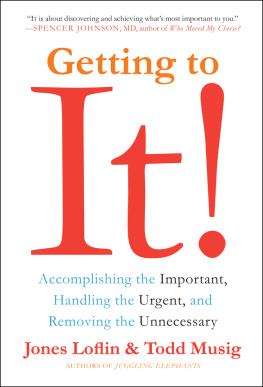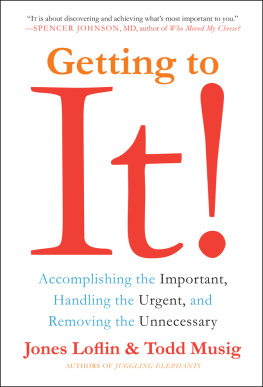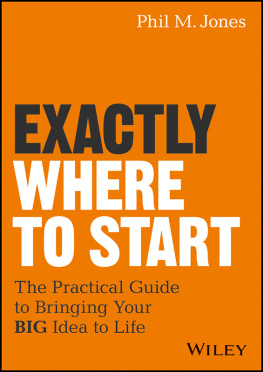To our families,
who are always the IT for us
There were many times during the past four years when we wondered if Getting to It would ever get done. We found ourselves constantly reaching into the manuscript itself for guidance and the motivation to stay focused on the writing and editing of the message. This finished book, however, would never have been completed without the help of some incredible people with whom we shared the journey and to whom we are eternally grateful.
It was Dr. Spencer Johnson who gave us the initial motivation and direction after we had the idea for Getting to It . We will forever remember his excitement, encouragement, and sage advice over dinner in San Diego several years ago. He has always taught us to keep it simple because simple solutions can surprisingly be the most powerful, and we have tried to follow his words with this book.
To say we have the best literary agent in the world is not a fair statement. We have the best coach, cheerleader, reviewer, constructive critic, and literary agent in Margret McBride. She never ceases to surprise us with her insight and ability to look at the big picture of writing and publishing books. Her assistant, Faye Atchison, is no less amazing. Fayes attention to detail with proposals and contracts helped all of us keep our sanity. And her personable nature makes her a delight to work with.
We are extremely excited to be a part of the HarperBusiness imprint. It became clear to us very quickly that Hollis Heimbouch and Colleen Lawrie got It. From support of this project to jacket design to editing and marketing, we are thankful for their vision of what this book can mean to so many people.
For the message of any book to be received well, it must be written well. Dennis Mathis of Close Readers was invaluable in the initial edits of the manuscript, making the flow more natural, the words more descriptive, and the concepts more clear.
From our early days of talking with Dr. Johnson we have known that feedback, while painful, is essential to creating a superior book. We are so appreciative of friends, family, and clients who read different versions of our manuscript and took the time to provide input that made the book stronger and of greater value.
Finally, we cannot end these acknowledgments without saying thanks to two other groups of people. We can never repay our wives, Lisa and Wendy, for putting up with our wild ideas and being patient as we spent time away from each of them to make this book a reality. And to our childrenAlex, Sydney, Vashti, Tayva, and Jacquelynit is you who gave us the daily validation that time is too precious to be focused on anything other than that which is most important.
Contents
IN YOUR STRUGGLE TO GET IT ALL DONE, WHATS NOT GETTING DONE?
At any time of day, do you find yourself saying When I get time, I will... or One day when things are different... and then realizing how familiar that sounds? Do you reflect on the past five years and become frustrated because youve yet to accomplish all the things you promised yourself youd get to by now?
What if a high percentage of your tasks and actions were actually contributing toward accomplishing those things that matter to you? What if you felt as if you actually had time to help other people, giving full attention to the needs of coworkers and customers?
What about life outside of work? What if you actually enjoyed taking your children to their activities and got your errands done in a quarter of the time it takes you now? What if some of the chores on your list became more enjoyable because youre confident in your ability to get your most Important Things done?
Would you laugh more often and feel more at ease? Would you feel respected and appreciated by clients, friends, neighborsand even, wonder of wonders, by your teenage children?
Would that be enough of a reason for you to continue reading this book?
What if your schedule allowed more time for personal growth, and you could finally give a higher priority to relaxing and enjoying life? What benefits might result from having the time and enthusiasm to pursue the passions that energize you, inviting you to tackle the long-postponed if only items on the bucket list of things youd like to experience in your life?
Its not that you havent tried to become more organized and efficient many times in the past. You might even use a daily planner or manage your to-do list electronically. You may have a smartphone with buttons worn away from your furious attempts to answer all of your e-mail on the go.
Its possible that other people already admire you as someone who has it all together. Do you privately wonder how much longer you can maintain your pace and your reputation for always delivering on time? Are you often merely getting by rather than thriving, hoping that something (other than retirement or winning the lottery) will come along to rescue you from this stormy ocean of hurry, deadlines, and the constant juggling act of balancing never-ending work and life demands?
What Is I T ?
There is a solution to help get you focused and pointed in the right direction. In a word: IT . Define IT . Plan IT . Focus on IT . Get others excited about IT . Celebrate IT . And then plan for the next IT . Consider this definition:
MAIN ENTRY: It
PRONUNCIATION: \it\
FUNCTION: Noun/pronoun followed by action
DATE: Today
DEFINITION: The most Important Thing
IT will save you from the avalanche of possibilities that await you every day at work. IT will make the difference in your reaching your full potential and your desired level of success. IT will help you develop and appreciate supportive, positive relationships. IT will guide you in defining who you are as an individual and as a professional, and in clarifying what is important to you.
Thats it? you say.
Yes, thats IT . Its that simple.
Asking yourself, Of all the paths I could take, which is the most important at this moment? may at first seem simplistic and obvious, and no different from what you do now.
The problem, you tell yourself, isnt in deciding what must be done; often circumstances or other people have made those decisions for you. The problem is in all the steps required to actually accomplish a number one priority.
For example, a marketing director might identify IT as a badly needed strategy for launching the companys new product. That part was easy. Execution is something quite different. Finding the time to devote to IT , getting people who are currently overloaded and already moving in twenty different directions to focus on IT , and securing the necessary financial resources from an already strained budget are far from simple tasks. The very next step after IT has been defined can result in frustration and delay. Maybe, in this example, the marketing director senses that a sales incentive strategya whole new, complex IT has to be developed to support the new marketing strategy. How does he decide which is the priority?
As you will see in the chapters to come, identifying IT isnt just the first step in a process, its every step.
Constantly stepping back and analyzing whats driving your choice of IT is more than just a useful exercise, its critical. Clarity of thought and purpose is necessary not only in determining IT , its essential to efficiently organizing all the steps required to accomplish IT .
I T: of everything you could do in the next moment, the most I MPORTANT T HING.
Certainly, defining one IT at the outset is crucial. Getting IT wrong can have disastrous consequences for individuals as well as entire organizations. Also, leaving IT undefined can cause priorities to be at cross-purposes with one another, making your days busy but rarely productive or meaningful.











